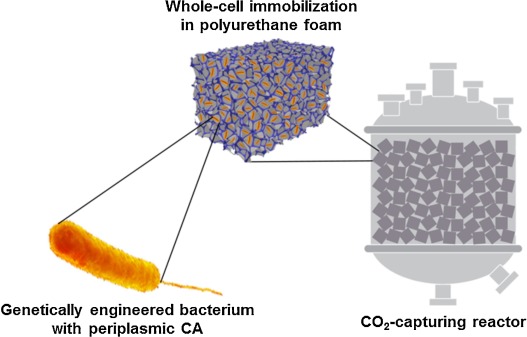
연구
Research Outcome
미래를 창조하는 포스텍 화학공학과
Immobilization of genetically engineered whole-cell biocatalysts with periplasmic carbonic anhydrase in polyurethane foam for enzymatic CO2 capture and utilization
- Title of paper
- Immobilization of genetically engineered whole-cell biocatalysts with periplasmic carbonic anhydrase in polyurethane foam for enzymatic CO2 capture and utilization
- Author
- [차형준교수 연구실] 탄산무수화효소 고정화 기반 이산화탄소 전환
- Publication in journal
- Journal of CO2 Utilization 2020, 39, 101172
- Publication date
- 20200701
[Abstract]
Carbonic anhydrase (CA), an enzyme that catalyzes the hydration of CO2, has been considered an attractive green catalyst for bioinspired CO2 capture and utilization. The construction and utilization of a CO2-capturing whole-cell biocatalyst offers potential economic viability for industrial applications. The recently engineered whole-cell biocatalyst with periplasmic CA from Hydrogenovibrio marinus showed superior activity and stability over other systems. On the other hand, it was prone to enzyme leakage and cell lysis, necessitating whole-cell immobilization. Herein, the periplasmic whole-cell catalyst was entrapped in polyurethane foam by a facile one-step copolymerization method. The functional immobilization of cells was achieved with an immobilization efficiency of 3.4 %, which was 16-fold higher than that for free enzymes. The catalytic activity increased linearly depending on the cell density and the number of cut pieces of the immobilized catalyst. Notably, the reusability of the immobilized whole-cell catalyst was excellent, showing no apparent decrease in activity after nine reuses. Unexpectedly, the entrapment of cells in polyurethane foam was not effective for the thermal stabilization of enzymes presumably due to the lack of a direct covalent linkage of enzyme to the polymeric matrix. The rate of CO2 capture in the designed reactor was accelerated by 80 % using the immobilized biocatalyst. We expect that the immobilized whole-cell biocatalyst can be used as an efficient and economic biocatalyst for practical CO2 capture and utilization, and the performance of the system would be greatly improved by optimizing various parameters in the construction of the catalyst.




